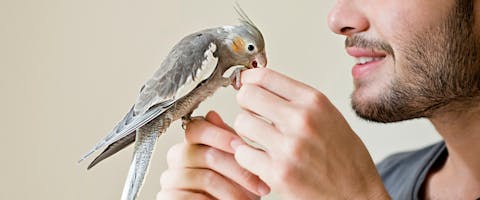Whether you already know what bird sitting entails or you’re completely new to friends of the feathered kind, here are nine bird care tips that will make caring for your beaky buddy a hoot.
Our top bird sitting tips
1. Make it personal
Our feathered friends come in all shapes and sizes, and bird sitters are likely to meet a flock of beaky buddies with varying needs. Care should be personalized not only to the type of bird you’re looking after, but also to each as an individual.
Patrick the parrot might love exploring outside his cage while Beatrice the budgie may be happier perched on your finger. For some, simple tasks like feeding and cage cleaning are enough, whereas others might require a more hands-on approach with lots of playtime and interaction.
Either way, pet parents should provide clear instructions on how best to care for their feathered family members.
2. Follow feeding instructions to a T
Pet parents will also explain how to feed their beaky babies, which will vary depending on the type of bird and their dietary needs.
Make sure your feathered friends have access to clean water at all times and remove any fresh fruit and veg if left uneaten at the end of the day. If pet parents recommend treats, this is a great way for a bird sitter to form a connection with their beaky buds.
Trending posts
Purr-use some of the top blogs our members have been loving this month- Top male dog names for your new furry friendGot a new furry family member in your pack? Check…

- Top female dog names for your new fluffy palWelcoming a new pooch into your family? Explore…

- 250+ gray cat names your silver feline will loveRecently welcomed a fluffy gray bundle of joy into…

- What are normal pet sitting rates?Discover the average pet sitting rates for animals…

- Unique dog names to stand out from the packDare to be different with our list of the best…

3. Keep fingers outside the cage
While still establishing a relationship with your new feathered friend, pet sitters should take things slow. The cage is your beaky buddy’s safe space and anything too intrusive could be deemed a threat.
4. Handle them with care
If pet parents have asked you to handle their feathered family members, do so with care (and wash your hands after). Pet birds often form a close bond with their owners but can be wary of strangers offering their hands out (no offense).
If you feel uncomfortable handling birds, chat with the owners about other ways to interact with their pets – there are plenty of games you can play with birds inside their cages!
5. Secure the room
It’s common for pet birds to spend some time flying around the house to stretch their wings – pet parents should give clear instructions on where and how often this should be done.
As a bird sitter, your job will be to ensure they’re let out in a safe, enclosed area. Doors should be shut, windows locked, fans turned off, and any other pet pals should be moved to another area of the house.
6. Stay calm
Pet birds are incredibly in tune with their surroundings and some even learn to mimic the words and expressions they hear from us. That being said, loud noises and shouting can signal danger to them, and a scared bird might attempt to flee or even attack if they’re feeling threatened.
7. Birds need their beauty sleep
To keep them from turning into grumpy feathers or getting sick, make sure your beaky friends get a solid 12 hours of shut-eye every night. Avoid making too much noise during this time and cover their cage so they can snooze in peace.
8. Beware of what you do around them
Strong smells and chemicals from cleaning sprays, smoke, fragrant candles, air fresheners, hairspray, and perfume can all be damaging to a bird’s respiratory system.
9. Don’t simply wing it
When discussing bird care with pet parents, be clear and upfront about your experience and what you’re prepared to do. Some birds need expert care and treatment while others are happy as a lark with just food and a clean cage. If pet parents do ask you to handle their feathered family members or let them out of their cage, make sure you’re comfortable doing so before you agree to it.
Tips and tricks for bird sitting - FAQs
How do I find a bird sitter near me?
If you’re a pet parent yourself, a little birdie told us you might be here to find someone to take care of your feathered family! Find bird sitters with TrustedHousesitters, who offer loving, round-the-clock pet care in exchange for a place to stay – you’ll never be short of a pet pal for your feathered family members!
How to make a bird like you?
Like with many pets, food is likely the key to your feathered friend’s heart, but speaking to them in a gentle voice can also make them feel comfortable around you.
How to pet a bird?
Start by petting them around the beak before gradually moving to other areas around the head, making sure to avoid anything below the neck. Be super gentle when handling birds in any way, and stop if they are showing any signs of discomfort.
How to get a bird to trust you?
Often a bird will learn to trust you over time, and simply being in the same room with them will help build up your bond. Learn to spot what makes your feathered friend comfortable and uncomfortable, from avoiding eye contact to keeping your voice low around them.
Do birds like being petted?
Some birds do, some birds don’t, so take it really slow if you decide to stroke your beaky buddy. Always avoid the area below the neck and concentrate on the cheeks and beak area instead.

